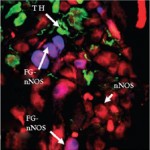Anaesthesia for robotic-assisted laparoscopic radical prostatectomy
 Here’s my technique for anaesthetising patients for robotic-assisted laparoscopic radical prostatectomy and I’d be interested to hear any thoughts, comments and ideas.
Here’s my technique for anaesthetising patients for robotic-assisted laparoscopic radical prostatectomy and I’d be interested to hear any thoughts, comments and ideas.
Pre-op. I try to fast the patients for as short a time as possible and also include pre-operative carbohydrate loading. This is in line with Enhanced Recovery After Surgery (ERAS) Guidelines for major bowel surgery and has been shown to reduce the negative nitrogen balance that occurs following major surgery. I use 200ml cartons of Polycal, which is clear and non-particulate, prescribed 12 and 3 hours pre-operatively. Clear fluids are encouraged up to 2 hours pre-op as this improves gastric emptying and minimises pre-operative dehydration.
Intra-op. I use a mixed technique of both general and regional anaesthesia. The general consists of a fairly standard technique with a Propofol induction and maintenance with Desflurane and a Remifentanil infusion. To reduce post-operative nausea and vomiting I use ondansetron, cyclizine and dexamethasone. The regional part is a spinal anaesthetic using 0.5% Hyperbaric Bupivacaine with additional intrathecal Diamorphine. Regional anaesthesia has been shown to reduce peri-operative DVT formation, probably by blocking sympathetic activity and improving blood flow through the legs, it also produces profound muscular relaxation enabling better pelvic vision and easier insufflation. In addition there is some evidence that appears to suggest regional anaesthesia may reduce the recurrence rate of prostate cancer. As the patients are positioned in a steep trendelenberg they are all intubated and ventilated with a small amount of additional PEEP to reduce pulmonary atelectasis.
Post-op. Intrathecal diamorphine usually provides 12-14 hours of good quality post operative analgesia. Intrathecal opiates act locally producing segmental analgesia and therefore do not produce the systemic side effects to the same degree as intravenous opiates. The ondansetron given peri-operatively may reduce the incidence of opiate induced pruritus as well as acting as an excellent antiemetic. Additional analgesia will be required but usually paracetamol and ibuprofen are sufficient. It is unusual for patients to require any additional stronger opioid medications and this is helpful in ensuring that gastric stasis and reduced gut motility do not occur. This enables the patients to be rapidly progressed on to a light solid diet that in turn further reduces the occurrence of a post-operative ileus.
Fluid Management. Using this starvation policy, patients should commence their surgery with only a minimum degree of dehydration. Remifentanil produces an extremely cardio-stable anaesthetic and with the patients being head down peri-operative hypotension is unusual. Should this however occur blood pressure should be maintained with the judicial use of vasopressors and fluid if necessary. Post-operative urine output can be maintained if required with plasma expanders and diuretics.
Richard Morey qualified from MHMS in 1987 and has been a Consultant Anaesthetist in SE London since 1997. His particular interests are ERAS/ Laparoscopic Surgery along with ENT and Difficult Airways.
Comments on this blog are now closed.



Hi Richard. Really useful comments. My experience of intra-thecal morphine (from the dumb surgeon’s perspective!!), was that it led to concerns about respiratory depression and on occasion patients would be recommended for HDU monitoring. For this and other reasons we therefore stopped any regional anaesthesia and find that the only analgesia required post-op is regular paracetamol and oxycodone as required. This has led to over 90% of patients being discharged on day one. Great to hear your thoughts. Declan
Thanks. It’s great to get some feedback and ideas. All opioids produce some respiratory depression. Some more than others and Oxycodone is not exempt. Intrathecal Morphine is not routinely used in this country due to the risk of respiratory depression but Diamorphine is used in many environments including obstetrics without the need for HDU monitoring. The major advantage is to avoid systemic opioids and their additional side effects. In addition the analgesia produced appears to be better. I have 2 friends ( and colleagues) who recently underwent RARP. I appreciate that n=2 but the intrathecal opiate produced better analgesia. More work needs to be done to confirm! Spinals should not prevent patients being discharged the following day and could increase the number.
Hello Richard,
I echo Declan with thanks for your very detailed description on the perioperative care of a patient having a robotic prostatectomy procedure. They are fantastic comments. It is interesting to see and read of subtle variations in practice.
I work with Declan and some of the other surgeons here performing this surgery and, as an anaesthetist with an interest in oncological anaesthesia, I constantly try to apply the evidence and best practice to our cases.
Much of your practice is very similar to my own. Some differences:
– We have not used spinal anaesthesia as part of an anaesthetic regimen simply because the patients’ post-operative analgesic requirements are so low. The argument for dvt prevention is solid and cancer prevention weak but certainly plausible – the evidence is very mixed. We are currently conducting research on this at our Cancer Hospital. Do you find the hyperbaric bupivicaine spreads cranially in the head down position?
– We have found a large (8mg) dose of dexamethasone assists with preventing emergence symptomatology of cerebral edema,
Overwhelmingly what you describe in your approach is what is developing as a ‘cancer anaesthetic’ as much as an ‘ERAS’ style anaesthetic. TIVA and post-operative Celecoxib may soon be the standard in this regard as well.
Again, thanks for your comments,
Jonathan
Thanks Jonathan
Previously I did not perform spinals for these patients and found that all required at least 1 dose of a systemic opioid. In my view, and this works really well for laparoscopic bowel surgery, we should be trying to avoid systemic opioids whenever possible. Hence my use of intrathecal Diamorphine. I administer the bupivacaine as I am already performing a spinal and I believe it will reduce the stress response to surgery. Is this why outcomes are better when Epidurals are used for open Radical Prostatectomies?
I’m not worried about cranial spread as I perform the spinal with the patient sitting prior to GA and by the time the patient is placed head down the spinal should be fixed. In addition the procedure lasts approx 2 hours so the spinal is beginning to wear off by the end.
I now routinely use 8mg Dexamethasone to prevent post op nausea and appreciate the added value for cerebral oedema. Interestingly many patients have a degree of post op euphoria. Any idea what to do for the 48 hour dip?
Thanks for your reply Richard.
I agree, the time course for your spinal injection of Bupivicaine should have it well fixed by the time they are head down. Post-op euphoria is not something we see as we have no access to diamorphine in Australia (just the intrathecal morphine). I had some experience with diamorphine used in an epidural when I was working in England. Micro doses of Naloxone helped alleviate symptoms in some patients in the same way that it can work with pruritis. I enthusiastically support the idea of a ‘cancer anaesthetic’ and stress response reduction (such as your spinal) may be a part of this. Beta blockers too? This may be a part of the statistical signal that occasionally gets picked up on cancer recurrence studies examining alterations in intra-operative anaesthesia techniques. Avoidance of opioids may also be a part of the potential benefit; many of the studies have not acknowledged the intense pro-opioid effect of the intra-operative Remifentanyl commonly used if the technique is done under regional anaesthesia. Difficult to know how to handle this. Thanks for your thoughts, Jonathan
Dear Richard,
Thank you for your description – a very useful discussion. I am an anaesthetist and also work with Declan and Jonathan and we have just finished looking at the anaesthesia for the first 2 years of the robotic prostatectomies in our hospital. The analgesia has been discussed already but the highest pain scores in PACU were low (median 4/10 IQR 0-5/10) so it seems that even without IT opioid pain is not a major concern. However, the ‘cancer anaesthetic’ is certainly something we should be striving to optimise.
In your comments you mention an operative time of 2 hours which is quite a bit faster than we usually see in our teaching setting – is this a fairly standard time in your institution? The times in the private sector are usually shorter but we are trying to strike a balance between efficiency and trainee experience.
We have certainly had a few challenges with ventilation at times due to the Trendelenburg positioning and the duration of the case and most of us are using a pressure controlled mode and accepting that the CO2 will be elevated by the end of he case. What ventilation strategy do you usually employ and do you find it troublesome to manage in these cases? Do you have any weight limitations on those accepted for robotic surgery?
Many thanks, Meg
Hi Meg
Thanks for the comments.
There is no teaching component which probably explains the operative time being shorter than you experience. I haven’t included induction time but in reality this is not usually much more than 15-20 mins including the performance of the spinal.
I agree ventilation can be tricky. I prefer volume control with the addition of 4-5cm PEEP. Whereas the mechanics of pressure control should provide better gas exchange I tend to find that fluctuating pressures within the abdominal cavity play havoc with minute volume and unless one is extremely vigilant can lead to significant hypoventilation. In reality most of the patients are not head down for more than 90 mins and so I have not had a major problem that hasn’t been resolved by a a few minor ventilatory adjustments.
I am intrigued by your relatively low pain scores without the use of regional blockade. If not using spinals I have found that most of the patients still require supplemental opioids in recovery. Spinals plus 2 hour ops produce a pain score of 1-2 in recovery a situation I’m comfortable with.
Hope this is of interest
Richard